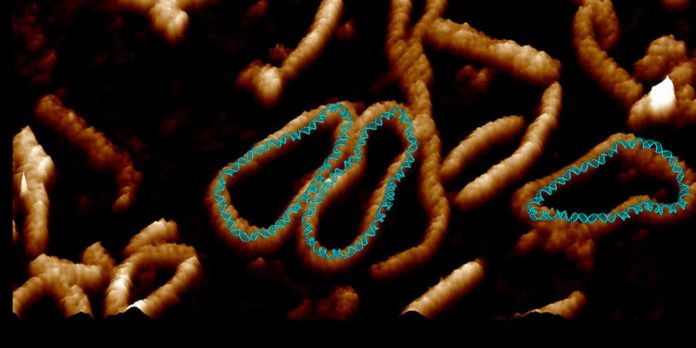Previously, DNA and chromatin structures can be visualized by using microscopes. But now, it is going to change. By combining advanced atomic force microscopy with supercomputer simulations, scientists at Yorkshire have created a dancing DNA visualization.
Scientists have created a video showing how small circles of DNA adopt dance-like movements inside a cell. It shows how the stresses and strains that are placed on DNA when it is crammed inside cells can change its shape.
The footage is based on the highest resolution images of a single molecule of DNA ever captured. The images are detailed enough that we can see the iconic double-helical structure of DNA.
When scientists combined those images with simulations, it shows every single atom’s position in the DNA and how it twists and writhes.
Dr. Alice Pyne, Lecturer in Polymers & Soft Matter at the University of Sheffield, who captured the footage, said: “Seeing is believing, but with something as small as DNA, seeing the helical structure of the entire DNA molecule was extremely challenging.”
“The videos we have developed enable us to observe DNA twisting in a level of detail that has never been seen before.”
To fit inside a cell, the DNA is formed in twisted structures that show more dynamic behavior than their relaxed counterparts.
To understand this entire process, scientists studied small packets of genetic information called DNA minicircles. DNA minicircles are unique because the molecule is joined at both ends to form a loop, which allowed scientists to give the DNA minicircles an extra added twist, making the DNA “dance” more vigorously.
While imaging relaxed DNA without any twists, scientists saw that it did very little. But when they gave the DNA an added twist, it suddenly became far more dynamic and could be seen to adopt some very exotic shapes.
Professor Lynn Zechiedrich from Baylor College of Medicine in Houston, Texas, said, “The research team in Yorkshire have developed a technique that reveals in remarkable detail how wrinkled, bubbled, kinked, denatured, and strangely shaped they are.”
“We have to understand how supercoiling, which is so important for DNA activities in cells, affects DNA in the hope that we can learn how to mimic or control it someday.”
Dr. Massa Shoura from Stanford University, who has detected DNA minicircles in human cells, said: “Very little is currently understood about the function of circular DNAs in cells, but there is a chance they could be used as markers for early detection of disease.”
Dr. Sarah Harris, Associate Professor in the School of Physics and Astronomy at the University of Leeds, who supervised the research, said: “The laws of physics apply just as well to the molecules that make up living systems as to sub-atomic particles and galaxies. Our experiments and computer models’ synergy show we are beginning to understand the physics underlying supercoiled DNA. This insight should help researchers such as Professor Zechiedrich design bespoke minicircles for future therapies.”
The study was conducted by a team of scientists from the Universities of Leeds, Sheffield and York.
Journal Reference:
- Lapin, Z. Seeing DNA. Nat Methods 14, 947 (2017). DOI: 10.1038/nmeth.4455
